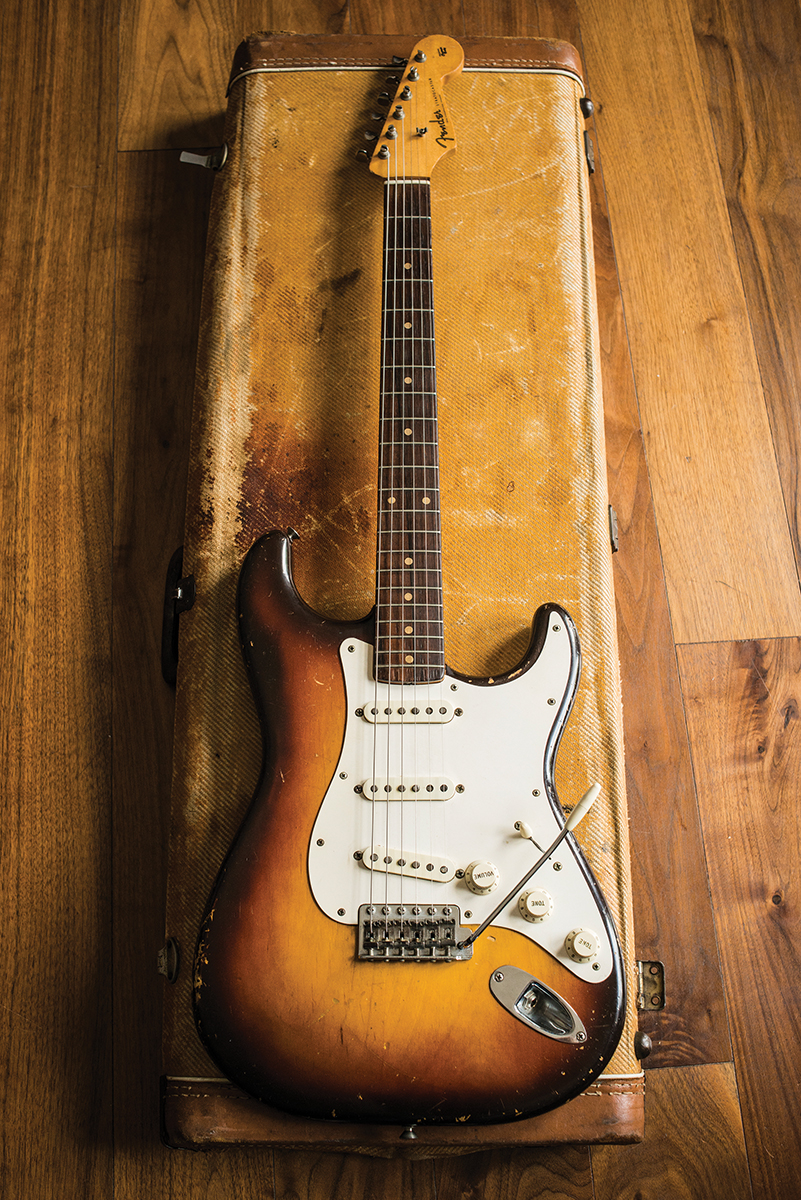Related Tags
The Ultimate Guide To Strat Tone
Whether you’re shopping for your first Strat or looking to breathe new life into an old favourite, when it comes to killer Strat tone, we have the answers. It’s time to turn on, tune in and rock out…

From Hank and Buddy through to Jimi, Clapton, Gilmour, Knopfler, SRV and beyond, the Fender Stratocaster has been at the heart of popular music for more than six decades. Despite its familiarity, its charms are still the source of mystery and wonder to many guitarists today.
When we think about improving our tone it’s just too easy to focus on the micro and ignore the macro. Although it must be said, buying electronic components, lumps of metal and so forth is a lot less exciting than waiting six months for a set of boutique pickups recommended by some random forum dude to arrive from the frozen wastes of Alaska. Nevertheless, in this tone quest, addressing the system as a whole is more likely to produce the desired results than a potentially dispiriting and financially ruinous cycle of smaller upgrades. This principle applies to all guitars, but none more so than the Stratocaster.
Over the next 12 pages, we’re going to provide you with what amounts to a holistic approach to Stratocaster tone optimisation. The topic is approached from various angles in the order we believe they should be addressed. Beginning with string choice and setup, we will consider hardware and electronics before moving on to pickups. This is based on a firm belief that the starting point for tone is a Strat that is properly set up and sounds good acoustically.
Before we continue, it’s worth noting that we’re going to be assuming you own a traditional stock Stratocaster here, with the usual pickups, controls, hardware and the like. If your Strat has humbuckers, a locking vibrato or other major mods then obviously some of this won’t be applicable – but equally a lot of it will. Let’s dive in…
STRING GAUGE
Selecting your strings is crucial, because a Stratocaster should be set up with the actual string gauge that you intend to use. The core diameter and tension of your strings determine how the Strat’s spring claw must be set – which in turn carries over to saddle heights, intonation adjustment and truss rod tension.
A great setup means two things – the guitar will play well, and you’ll actually be able to play the damn thing for more than five minutes! That may seem like a statement of the obvious but Stevie Ray Vaughan’s reputed predilection for ultra-heavy strings has led plenty of us to ponder the optimum pain to tone ratio.
Fat strings can sound fantastic with vintage-style single coils because they solidify and fatten up the tone, and provide higher output levels without the dullness of overwound pickups. However if you’re struggling to bend a full tone and your fretting hand cramps up after a few minutes, your guitar may indeed sound great, but you won’t.
Remember that SRV detuned a half step, which would have made the 0.012-gauge sets he preferred when his fingers were sore feel more like 0.011s. Also consider the material, because pure nickel sounds warmer than nickel plated steel and round cores will sound more ‘vintage’ than hex cores. Base your string choice on what sounds good to you, the pitch you prefer to tune to and the gauge you can realistically manage.
SETTING UP
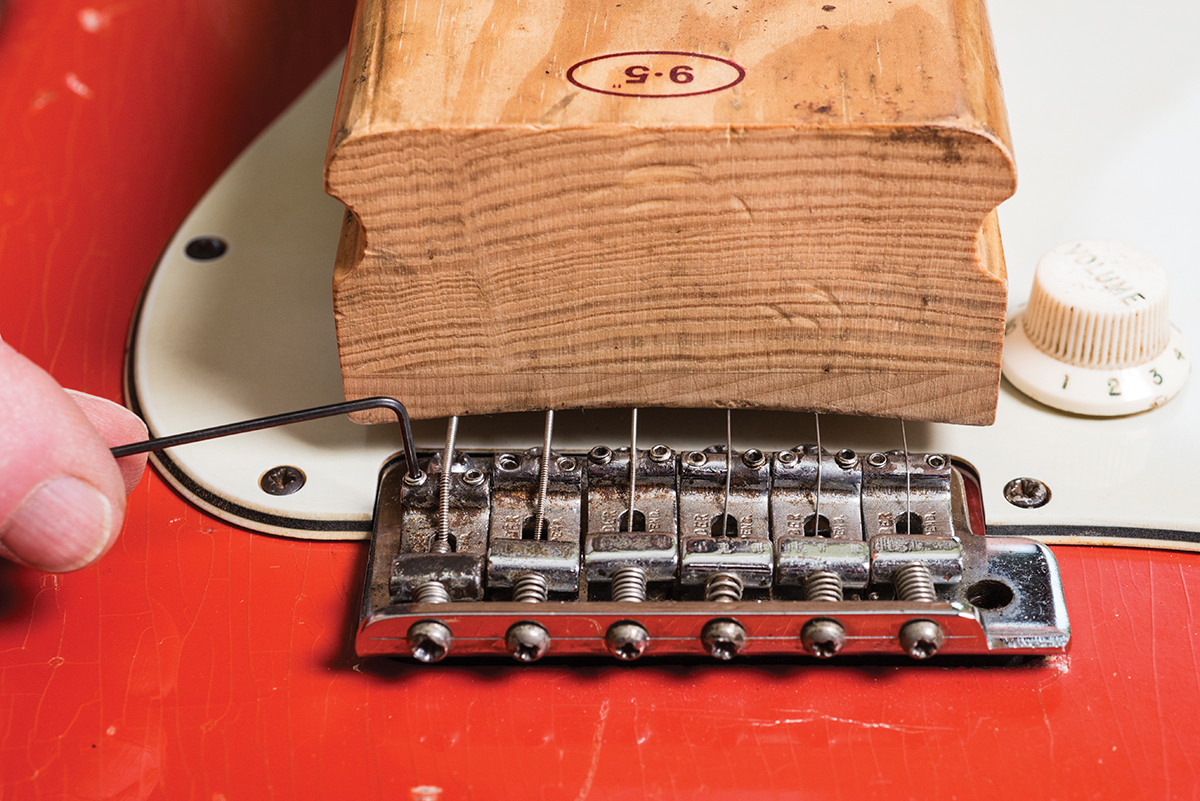
The alchemy of setting up a guitar is deserving of a publication all of its own, so we’ll restrict ourselves to the aspects that have the most impact on tone – and that starts with the vibrato. It’s up to you whether you prefer to block it off, have downward movement only, or float it for up and down pitch shifts, however what you choose does have some bearing on sonics.
Blocking off a trem by wedging a piece of wood between the block and the back of the spring cavity tends to thicken the midrange and soften the transients for a more compressed tone. Some claim it improves sustain – Clapton is a fan. In contrast, floating the trem tends to open up the sound and allow the treble harmonics to ring a bit clearer. You may also discern a bit more of the Strat’s springy ‘internal reverb’ and you can enhance this effect by removing the spring cover.
For a Strat to sound its best, the strings must be able to ring cleanly and this is achieved through adjustments to the truss rod tension and saddle heights. Strings vibrate in an arc with minimum displacement near the nut and bridge. If the fingerboard is set too flat the strings tend to buzz against the frets and a very slight degree of upwards curve (aka neck relief) can prevent this.
Even if you aren’t experiencing fret noise, you may notice that the tone becomes warmer and fuller as relief increases. However the guitar may feel harder to play, so try to find a compromise setting by trusting your ears and your fingers. Similarly, you have to rely on your ears when you’re adjusting the action. Set too low, the strings will choke out against the frets when you bend them, and this is most apparent on B and top E strings. If you want clean bends and maximum sustain you have to set the saddle heights so that the strings can be bent without choking out.
The fingerboard radius and, to a lesser extent, the condition of the frets determine how low the action can go. Since modern Fender Strats have 9.5-inch radius fingerboards and vintage spec is 7.25 inches, the unwound strings must be set higher for optimum Strat tone than they might be on guitars with a flatter fingerboard radius. If you’re struggling with higher action, try lighter strings.
WIRING
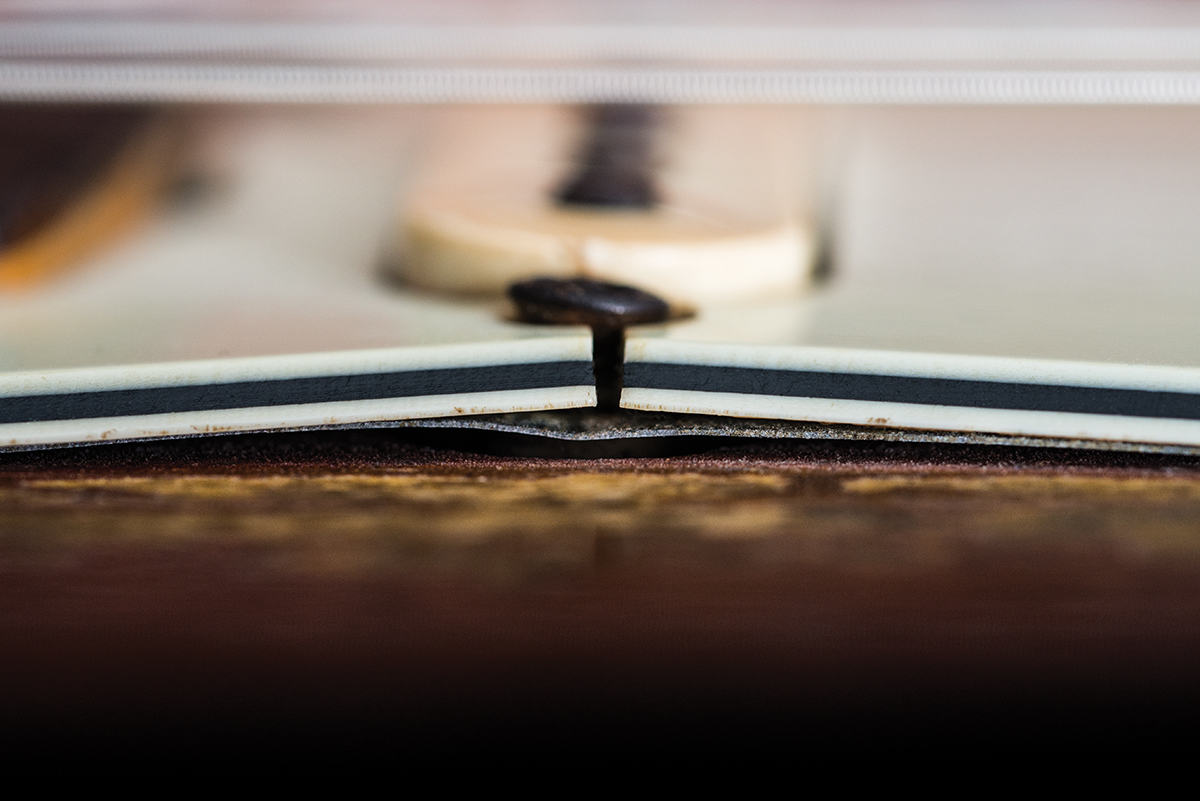
With three pickups, a five-way switch, three control potentiometers and an abundance of space under the pickguard to play with, it’s hardly surprising that there are more wiring mods for Strats than any other type of guitar. Here, were looking at what you can do with a Strat with stock features. When we consider Strat electronics, one aspect is often overlooked and it plays a subtle yet important function in the vintage tone equation – from the late 1950s until 1967 Fender used a 14-gauge aluminium shield under the pickguard.
Various metals can be used for shielding however the effectiveness of a single layer under a pickguard is questionable. More interesting is the effect aluminium has on Strat tone due to ‘paramagnetism’. Fitting an aluminium shield has a clearly audible effect, with rounder mids and a vocal ‘ooh’ tone for single notes. You can buy a shield for around £10 and they’re easy to fit – it doesn’t even require any soldering.
The value of the tone capacitor is another often overlooked feature. Contrary to popular belief, tone controls continue bleeding treble even when they’re supposedly turned off.
If you need convincing, consider how the bridge pickup of vintage-style Strat sets usually sounds disproportionately bright compared to the middle and neck.
It’s because stock Strat wiring leaves the bridge pickup unconnected to a tone control. If you ever feel the need to even things up, simply install a jumper wire to allow the bridge and middle pickups to share the same tone control. Since tone controls are always in-circuit, it follows that the tone capacitor’s value must influence a Strat’s treble characteristics. In 1964, the Strat’s 10th anniversary coincided with a change in cap value from 0.1uF to 0.047uF.
In guitar circuits, there’s treble roll-off and a resonance peak at the roll-off frequency. All things being equal, a Strat will sound brighter with a 0.047uF tone cap than it will with a 0.1uF. This is due to the roll-off frequency and resonance peak occurring higher in the audio spectrum.
Until now, we’ve been considering ways to optimise your guitar, but this is where we move onto modification. So long as you are not buying some fancy relic’d replicas, tone capacitors are cheap and easy to find. You could try paper/oil, ceramic or modern film capacitors to discover which you prefer, and while you may discern some subtle difference in tone and response between the various types, it’s the value that’s paramount.
If your Strat sounds too bright, try fitting a 0.1uF cap. If you want to brighten things up, go for 0.047uF. If you’re using hot wound pickups and find them too dark, you could even go to a 0.022uF or 0.033uF. Potentiometer values have a big influence on tone, too, because they effect the resonance peak at the cutoff frequency. Large value control potentiometers make guitars sound brighter by accentuating the resonance peak.
Fender has always used 250k pots in Stratocasters, except for a brief period in 1954 when the very earliest Stratocasters had 100k pots. We’ve tried these in a 1954 replica and there is a very noticeable sweetening of the treble and a smoother quality to the tone overall.
However, you do lose some glassy sheen and shimmer. You can darken, brighten, smooth out or add edge to your tone simply by altering component values or fitting a shield. What’s more, you can do all three for £15 or so, which may be less than a tenth of the cost of that mojo-infused, hand-wound pickup set you’ve been lusting after…
HARDWARE
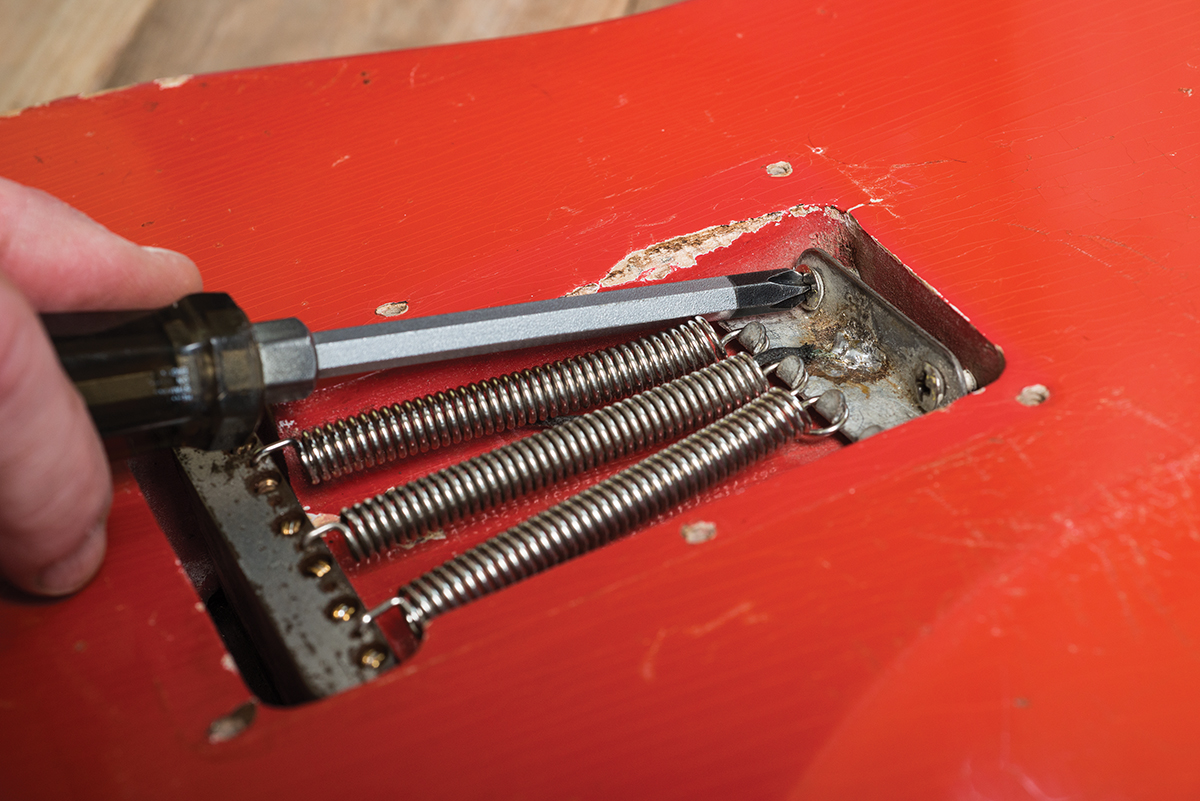
With Strat hardware there are three areas of interest – the vibrato block, saddles and springs. It’s odd how some guitars seem to sound best with lightweight aluminium hardware while others benefit from heavier metals. Fenders in general, and Strats in particular, tend to fall into the latter category.
They no doubt have their adherents, but the cheap alloy units that replaced the bent steel saddles of the pre-CBS era are considered to be the worst for tone. Steel rings clearer and brighter and stainless steel sounds brighter still. Slippery Graph Tech saddles are popular with heavy whammy bar users, but can sound dark and lack bite. Brass saddles were a popular mod in the 70s and 80s and are claimed to improve sustain and thicken up tone.
Strat bridges with detachable blocks can also be modded. Heavy steel blocks were used in pre-CBS Strats and you can buy UK made replacements from Kevin Hurley or Wudtone for a variety of bridge types and screw spacings. You can expect more open treble, improved definition and longer sustain than with cheap alloy blocks.
Also consider Killer Guitar Components’ brass blocks and brass spring claws if you want a beefier tone with smoother transient attack. While you are changing blocks – or merely changing strings – try Eric Johnson’s trick of removing the paint from the top of the block for direct metal-to-metal contact. He also removes lacquer from the neck pocket and the area beneath the bridge.
Alternatively, check out Wudtone’s ‘Whacker Plate’ – a 0.5mm sliver of stainless steel that sits between the body and bridge plate to enhance bridge-to-body contact (see our review of various Wudtone Strat upgrades on p88). It improves definition and clarity while providing a smoother vibrato feel.
PICKUPS
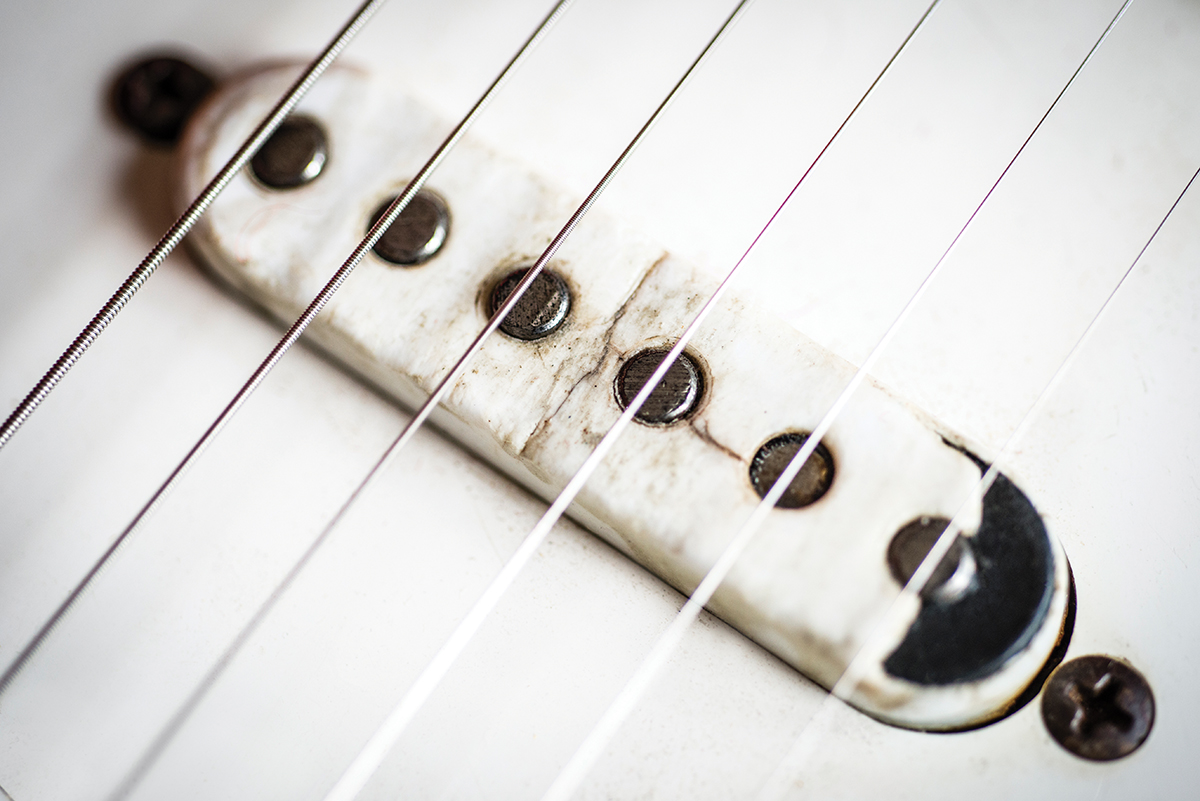
Pickup swapping is probably the most popular Strat modification and deservedly so because it has the biggest tonal impact of all. However it can be the most expensive, and often the cause of greatest frustration.
If you take one lesson from this feature, it should be that pickup upgrades provide the best bang for buck when you’re optimising a guitar that already plays well and sounds good acoustically. In other words, top quality pickups should be regarded as a finishing touch rather than a miracle cure.
For classic Strat tone, alnico magnets are essential. Some like bright yet softer-sounding alnico III slugs, but post-1955 Fender used alnico V slugs with bevelled edges. The bevels are also important for vintage tone. Until 1973 the slugs were staggered, however, Monty’s and Lollar have both told us that flat slugs provide the most even string-to-string response.
Scatter winding is a staple of most boutique pickups and heavy formvar wire is recommended for pre-CBS tone. Hendrix and Gilmour fans may wish to experiment with plain enamel wire. Hand-winding ensures the wire layers are less tightly packed – lowering the capacitance of the pickup and raising the resonant peak to achieve a clearer and brighter tone.
One sonic attribute that we have found is common to all great-sounding vintage Strat pickups is some degree of microphony. Whether this is attributable to partial wax potting or a gradual loosening of the coils is debatable, but the upshot is an extra level of upper-harmonic sheen and vibrant touch dynamics that make a guitar feel alive. Relatively few of the boutique winders are able to replicate this 100 per cent convincingly, but House Of Tone certainly can.
PICKUP HEIGHT

The height of the pickups relative to the strings is crucial to dialling in your tone. Adjusting them is the only way to explore the full tonal potential of your pickups and after tweaking, your pickups may actually sound better than ever. Experimenting costs nothing and all you need is a screwdriver. As long as the polepieces aren’t touching the strings or the pickups aren’t falling off the adjustment screws, any height is fair game and your ears will know when something’s wrong. One hazard of setting the pickups too high is excessive magnetic pull on the strings. Magnetism inhibits string vibration, which reduces sustain and in extreme cases causes pitch anomalies. You are most likely to hear these as an atonal honk when playing the low E and A strings above the 12th fret.
Setting a pickup high emphasises treble and increases output level. But if you go too far you lose sustain and the tone can become excessively shrill. Lowering will tame the aggression and provide a smoother, sweeter and clearer tone. Go too low and reduced sensitivity and low output may become issues.
As with all things guitar, compromise is key. Optimising your pickup height settings may not be the magic bullet, however it’s absolutely essential to get all three balanced.
Set your amp at a medium volume with a neutral frequency response and switch to the bridge pickup. As you raise the height, listen to the way the sound changes. For now keep the pickup flat rather than tilted and listen for tonal character and output level. Once you’re happy, pick through the notes of an open E chord and fine-tune the pickup height so the low E and A strings are equal in volume level to the B and high E. You can try playing chords higher up the neck, too.
If the bass strings dominate, lower that side. If the treble strings are too bright, then lower that side. A little goes a long way and remember this is about achieving balance rather than adjusting bass and treble. That’s what your amp’s tone controls are for. With your bridge pickup adjustment complete, switch to the neck. Again the goal is to get a balanced tone from the pickup but we’re also trying to match its output level with the bridge pickup. Switch back and forth between the bridge and neck for reference. Using vintage style sets, where all three have the same DC resistance, the neck pickup will end up lower than the bridge.

Use the same procedure for the middle pickup and compare it with the neck and the bridge. Some Strat players rarely use the middle pickup, unless it’s in the in-between settings and you can actually fine-tune the phasiness if you work quickly. Try holding a chord with one of the in-between settings selected. You should be able to hear the phasiness and quackiness change as the height changes.
Enjoy it, let your ears guide you and don’t forget to check out the tonal differences between spacer springs and neoprene tubing. The springs may make your tone brighter and more microphonic – seriously!
WOOD & FINISH
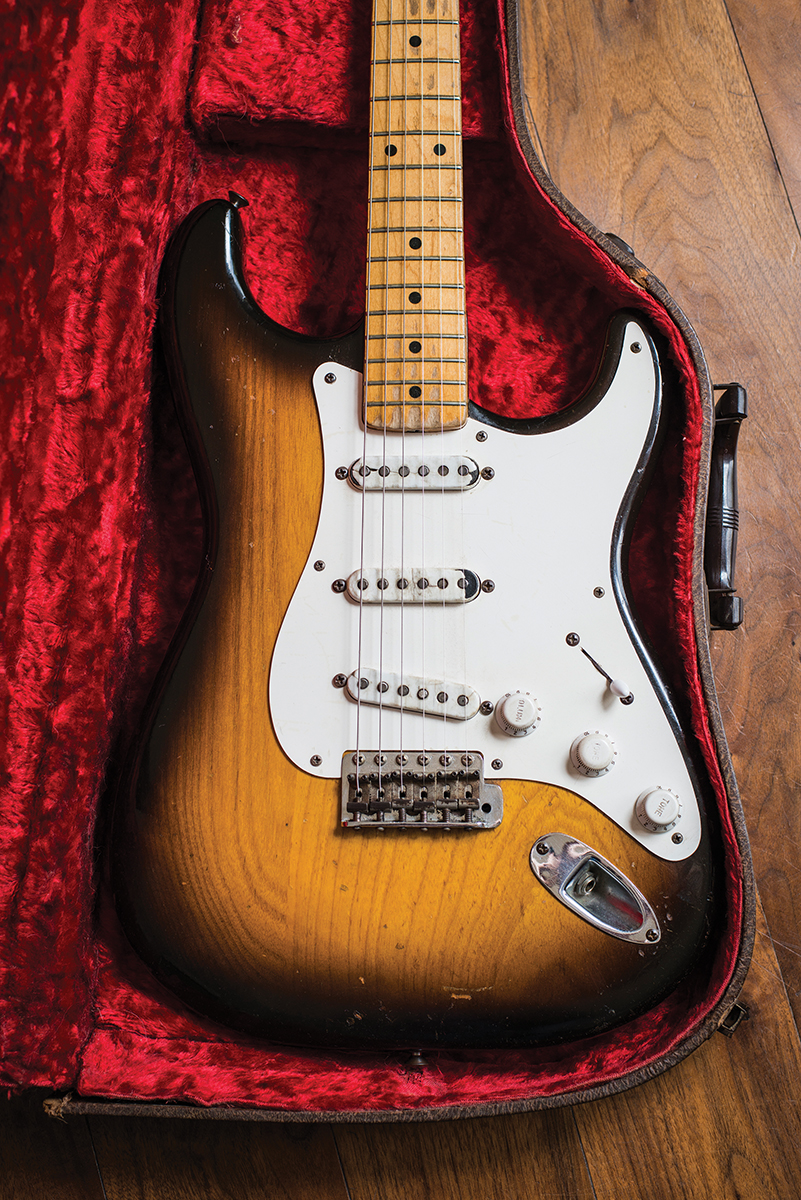
Hitherto we’ve confined our discussion to things you can do to your current Stratocaster, however there are some aspects you might want to consider when buying a Strat. An understanding of tonewoods and neck dimensions will help you make informed choices. You may see basswood or other timbers on budget instruments but we’re talking tone.The very best Strats then and now have alder or ash bodies – although rare mahogany bodied Strats have been reported from the pre-CBS era.
Bodies with a lighter weight tend to resonate more freely. Ash is associated with a bright and clear tone with fast attack and deep lows. Alder tends to sound fatter in the mids and maybe a tad warmer but each is a fine tonewood in its own right.
Stratocaster necks have almost always been maple but they’re often designated as ‘maple necks’ or ‘rosewood necks’ depending on the fingerboard. The earliest were one-piece maple, before Fender the introduced slab rosewood fingerboard that evolved into the veneer rosewood board – as seen on SRV’s Number One. Later ‘maple necks’ from the Hendrix era had glued on maple boards.
Maple necks are generally associated with bright tone. But since they were more of a 50s feature, when bright ash bodies combined with bright under-wound pickups, we suspect the maple board is the least of it. Having swapped rosewood and maple necks on an alder-bodied Strat, we feel the board material has more impact on feel than tone.
However, neck size does seem to be a factor and we have found that deep and substantial necks impart a snappier and brighter tone with a touch more sustain. Thinner necks sound great too, but we associate them with slightly warmer and darker tone. On balance we think the body wood and its weight have more overall influence and you’re better off just picking a neck that feels good to play.
Nitrocellulose looks gorgeous, ages gracefully and allows guitars to resonate – but it’s not the only finish that does so. Run the rule over top acoustic builders such as Collings, Taylor and Bourgeois and you’ll find that a variety of modern finishes are considered to be compatible with outstanding tone. We’ve played great sounding Strats with poly finishes, and poor ones, too. The most important thing is that the finish should be thinly applied, irrespective of the material.
KILLER STRAT AMPS
MARSHALL SUPER BASS
Any list of great amps for Strats would be incomplete without a big Marshall head. The 100-watt Super Lead might be the obvious choice but the inherent brightness can render a Strat’s bridge pickup a no-go zone. There were relatively few circuit differences between the two when they were first introduced, but the Super Lead evolved over the years while the Super Bass stayed the same. They work superbly with Strats because they overdrive easily and the absence of bright caps keeps things smooth – allowing you to dime the treble and presence controls without the ice pick top-end. A long time favourite of Gary Moore and John Frusciante.
DUMBLE STEEL STRING SINGER
Few of us will ever get the chance to play one of these, and the 12 or so existing examples are destined to spend eternity circulating through the hands of wealthy collectors and celebrity players such as Joe Bonamassa, Eric Johnson and John Mayer. This is among the most fabled of amps because it’s the one SRV used to record most of Texas Flood in Jackson Browne’s studio. It’s thought to have belonged to Browne’s guitarist, David Lindley. Primarily designed for clean headroom, clarity and high volume, these amps compress and overdrive very nicely, too. Clones are available from Two-Rock, Ceriatone, Sebago and Amplified Nation.
VOX AC30
Maybe it’s the amp’s thick and chewy midrange, the natural compression of cathode-biased EL84s or the joyous chime of the Celestion Blue alnico speakers, but the combination of a Vox AC30 and a Stratocaster has been a genre-hopping dream team for countless guitarists over the years. Hank Marvin must have been the first with his echo-drenched melodies and The Edge put his own spin on things 20 years later. In between there was Rory Gallagher and Ritchie Blackmore, who recorded with this setup throughout the Deep Purple and Rainbow years.
FENDER TWEED DELUXE
Just as the Stratocaster evolved through the 1950s, so did Fender’s revered tweed Deluxe models. From A to E they’re all fantastic in their own way but it’s interesting to note how the Deluxe models and Strats evolved in opposite directions – as the amplifiers became brighter and thinner, the Stratocasters got warmer and fatter. Each of these amp models can generate wiry and quacky Strat tones, sweetly saturated shimmer and full on crunchy distortion that borders on metal and they interact superbly with a Strat’s onboard controls. Plug a good Strat into a tweed Deluxe and you might suddenly find that you don’t need stompboxes at all…
FENDER DELUXE RVERB
Of all the classic Fender amps, the 22-watt Deluxe Reverb has just the right levels of volume, clean headroom and overdrive onset to be usable in most modern playing situations. Another great thing about these amps is that they carry two of the effects that Strats love best onboard – spring reverb and tremolo. The Silverface and Blackface models are almost identical electronically, so you can easily convert one to the other. This great all-round amp can do surf, blues, country, funk and classic rock. You can get beautiful mid-scooped early John Mayer tones, while pumping the midrange and the input with a Tube Screamer gets you close enough to SRV, too.
ESSENTIAL STRAT EFFECTS
FUZZ
For wrenching more body, sustain and sheer aggression out of a Stratocaster, a fuzz box is a sure thing. However, the effect can vary so much depending on the circuit in question. Fuzz Face circuits with germanium transistors work for early Hendrix tones, but Floyd fans may prefer the later silicon transistor Fuzz Face that David Gilmour used on The Dark Side Of The Moon. Later, Gilmour began using various Electro-Harmonix Big Muff pedals for their smoother and more velvety sustain and it’s a favourite of alt-rockers, too. Many Strat players use a cranked Fuzz Face with the guitar’s volume rolled back to tame the sizzle – it’s super touch-sensitive and more articulate that way.
OVERDRIVE/BOOST
Most Strat pickups have relatively low output, so they may need a little help to achieve the required amount of overdrive. The Ibanez Tube Screamer circuit has long set the standard because it bolsters the midrange and rolls off the top end to keep treble sweet. Most modern overdrive pedals offer some variation on the Tube Screamer circuit, but also check out the Boss OD models and Yngwie Malmsteen’s favourite DOD 250. Long before pedal overdrive, players used boost pedals such as the Dallas Rangemaster and the Hornby Skewes to force amps into overdrive. Modern boosts with Klon type circuits offer higher fidelity, improved playing dynamics and subtle shades of drive.
DELAY
Maybe it’s the Strat’s clear and defined tonal character that makes it the most common choice for echo obsessives. Hank Marvin set things off with his Meazzi Echomatic and if you couldn’t afford one of those a WEM Copycat would have to do. The Binson Echorec could get seriously psychedelic in the hands of David Gilmour. He also pioneered the use of complex delays for building atmospheric rhythmic patterns. The Edge picked up the baton and developed the theme. Although he started off with Memory Mans, the advent of digital delays such as the Korg SDD-3000 and TC 2290 – often used simultaneously – allowed precise syncing of delay times with tempos.
REVERB
Reverb can seriously muddy up some guitars, but it tends to work like a charm with Strats. In fact a Strat with a clean amp and a ton of reverb is just about all you need to play surf guitar. Lots of the old blues players liked to max out the reverb on their Fender amps, too. Just a hint can add a 3D quality to picked arpeggios. Increase reverb intensity and the decay time and you can create washes and keyboard-like pads. It’s also fun to ride the volume control to create swells into a heavy reverb effect. James Wilsey is the king of Strat atmospherics – if in doubt, check out Wicked Game for its heart-melting combination of Strat and Deluxe Reverb with a pre-delayed stereo chorus.
VIBE
Rotating Leslie speakers were designed for use with Hammond organs, but mid-60s guitarists fell in love with the phasey swoosh and playing guitar through them became a popular studio trick. Unfortunately the size and weight of a Leslie cabinet is closer to that of a small outbuilding than the average stompbox. Along came the Shin-ei Uni-Vibe and guitarists had a portable phase/vibrato/chorus device for Doppler fun in a gig-friendly format. Most synonymous with Hendrix, the Uni-Vibe is a key component in Robin Trower’s tone and David Gilmour has also used them extensively. Even smaller versions are now available from Dunlop, Fulltone, Sweet Sound and TC Electronic.
CLASSIC STRAT TONES
Bold As Love features some stellar examples of Jimi’s playing and tones, however we’re going to focus on the psychedelic solo that finishes the track. It’s hard to hear everything that’s going on because of the heavy effects, but we think it’s probably incorrect to say tape flanging was used on Jimi’s solo. The swooshing and swelling of stereo image is confined to the drums and the cleaner rhythm guitar part. Jimi’s guitar stays firmly locked on one side of the mix through most of this section, however there is a modulation effect on the guitar and we think it’s almost certainly a Uni-Vibe. Throw in a germanium Fuzz Face and a Marshall, and go crazy.
ERIC CLAPTON – LAYLA
When he fancied a change of direction the young Clapton didn’t do things by halves, and for the Derek & The Dominos album he ditched the Marshalls and the Gibsons to rock up with a 1956 alder-bodied Strat called Brownie and a Champ, likely of a similar vintage. An original ’56 Strat might be a stretch but a Champ is still the cheapest tweed. Fender, Rift and others make repros and they’re the simplest amp kits to build. With only a volume control to deal with, simply plug straight in, select your preferred pickup and crank up for the boxy and compressed mid-focused crunch of the opening riff.
THE SHADOWS – APACHE
As well as being a huge hit and a major influence on most of the great British players of the 1960s, Apache is surely one of the most sampled guitar tracks of all time, and one of the greatest sounding. It was recorded in 1960 and Hank Marvin would have played his late-50s Strat through a Vox amplifier – either an AC15 or one of his newer AC30s. With that combination it’s hard to go wrong, but the real magic (besides Hank’s special touch) comes from the effects. Hank used a Meazzi Echomatic multi-tap echo unit gifted to him by Joe Brown and the engineers added reverb using one of Abbey Road’s purpose-built reverb chambers.
MARK KNOPFLER – SULTANS OF SWING
Nowadays he’s seldom seen with them, but the man who finally killed the three-way switch will forever be associated with a red, maple ’board 1961 Stratocaster. Knopfler’s parts were probably recorded through the bright channel of a brown tolex Fender Vibrolux amp that may have been fitted with a 12-inch Fane speaker. You can hear compression, but it’s more likely a studio unit rather than the oft-suggested Dan Armstrong Orange Squeezer. The intermittent chorus effects would have been done with a Roland Jazz Chorus amp or with a Roland Dimension D processor. Crank to the edge of overdrive and select an in-between pickup setting.
DAVID GILMOUR – SHINE ON YOU CRAZY DIAMOND
This track is like a taster menu of Gilmour’s Strat tones. His amps were reputedly a Fender Dual Showman and a Hiwatt DR103 and he played his black Strat throughout. The dark lead lines in the intro presage his Another Brick In The Wall Pt 2 solo (though that was a P90 Goldtop) with copious compression and a DI neck pickup tone. The main figure sounds like the bridge pickup played through a Leslie rotating speaker and it’s mic’d in stereo. The first solo has a compressed but clean tone, but Gilmour lifts the dynamic with extra bite and a hint of crunch from a Colorsound Power Boost on the turnaround, later adding an MXR Phase 90 – and all within the first eight minutes.
STEVIE RAY VAUGHAN – LENNY
For the ultimate in pure, shimmering Stratocaster tones in the hand of a master player, it’s hard to think of a finer example than this cut from SRV’s debut album. Recorded with the guitar he called ‘Lenny’ – comprising a ’65 alder body and a replacement maple neck – the El Mocambo video clearly shows flat slugs, so the pickups were almost certainly post-1973 Fenders. You can get close to this tone with any vintage-style Blackface Fender amp but the fat mids suggest the 15-inch speaker of a Vibroverb, or maybe a Dumble. Lenny’s vibrato was free floating and the lush reverb is a studio effect – probably coming from an EMT plate or an AKG spring.


